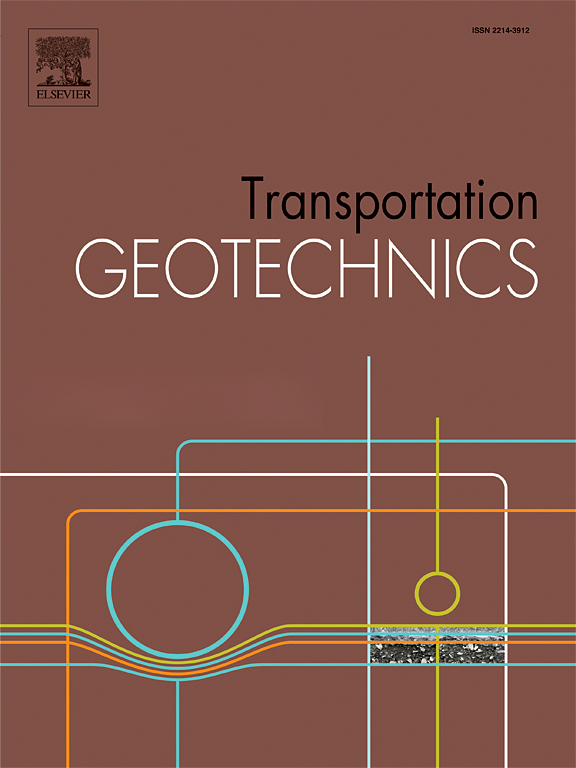Integral railway bridges with different transition zone designs
IF 5.5
2区 工程技术
Q1 ENGINEERING, CIVIL
引用次数: 0
Abstract
Integral bridges interact strongly with their backfills, especially due to seasonal thermal loading. So far, most research has focused on this cyclic soil–structure interaction of integral bridges with granular backfills. However, due to higher train speeds or axle loads, railway transition zones internationally must often be designed with wedge-shaped cement-bound granular mixtures. Also, transition slabs are widely used for longer integral bridges. Therefore, a numerical investigation is presented on the cyclic soil–structure interaction of integral bridges with different railway backfill designs. The main focus lies on the cyclic mobilization of lateral stresses and settlements in the backfill. Next to well-graded granular backfill, the comparison includes two forms of cement-bound wedges as well as concrete transition slabs. The numerical studies further cover both, varying bridge lengths and abutment heights. The obtained results highlight significantly different settlement accumulations for the various transition zone designs. A comparison with analytical design approaches is conducted and recommendations for the design of transition zones for integral bridges with different total lengths are derived. In the second part of the paper, results of a three-year-long monitoring of an integral railway bridge are presented. The cyclic development of both earth pressure and settlements are investigated by means of 3D FE back analysis. The study reveals that the interaction behaviour and earth pressure distribution is strongly affected by a concrete sealing layer of (only) 30 cm at mid-height of the backfill. The measured behaviour can be reproduced well, which further confirms the eligibility of the FE model and its calibrated constitutive model.
不同过渡区设计的整体铁路桥
整体桥梁与回填体相互作用强烈,特别是由于季节性热负荷。迄今为止,大多数研究都集中在具有颗粒状充填体的整体桥梁的这种循环土-结构相互作用上。然而,由于较高的列车速度或轴载荷,国际上的铁路过渡区通常必须设计成楔形水泥结合颗粒混合物。此外,过渡板广泛用于较长的整体桥梁。为此,本文对不同铁路回填方案下整体桥梁的循环土-结构相互作用进行了数值研究。研究的重点在于充填体中侧向应力和沉降的循环动员。在分级良好的颗粒回填体旁边,比较包括两种形式的水泥粘结楔和混凝土过渡板。数值研究进一步涵盖了不同的桥梁长度和桥台高度。所得结果突出了不同过渡带设计的沉降累积差异显著。通过与解析设计方法的比较,得出了不同总长度整体桥梁过渡区设计的建议。在论文的第二部分,介绍了对一座整体铁路桥梁长达三年的监测结果。采用三维有限元反分析的方法研究了土压力和沉降的循环发展。研究表明,充填体中高处(仅)30 cm的混凝土密封层对相互作用特性和土压力分布有强烈影响。结果表明,所建立的有限元模型及其校正本构模型具有较好的适用性。
本文章由计算机程序翻译,如有差异,请以英文原文为准。
求助全文
约1分钟内获得全文
求助全文
来源期刊

Transportation Geotechnics
Social Sciences-Transportation
CiteScore
8.10
自引率
11.30%
发文量
194
审稿时长
51 days
期刊介绍:
Transportation Geotechnics is a journal dedicated to publishing high-quality, theoretical, and applied papers that cover all facets of geotechnics for transportation infrastructure such as roads, highways, railways, underground railways, airfields, and waterways. The journal places a special emphasis on case studies that present original work relevant to the sustainable construction of transportation infrastructure. The scope of topics it addresses includes the geotechnical properties of geomaterials for sustainable and rational design and construction, the behavior of compacted and stabilized geomaterials, the use of geosynthetics and reinforcement in constructed layers and interlayers, ground improvement and slope stability for transportation infrastructures, compaction technology and management, maintenance technology, the impact of climate, embankments for highways and high-speed trains, transition zones, dredging, underwater geotechnics for infrastructure purposes, and the modeling of multi-layered structures and supporting ground under dynamic and repeated loads.
 求助内容:
求助内容: 应助结果提醒方式:
应助结果提醒方式:


